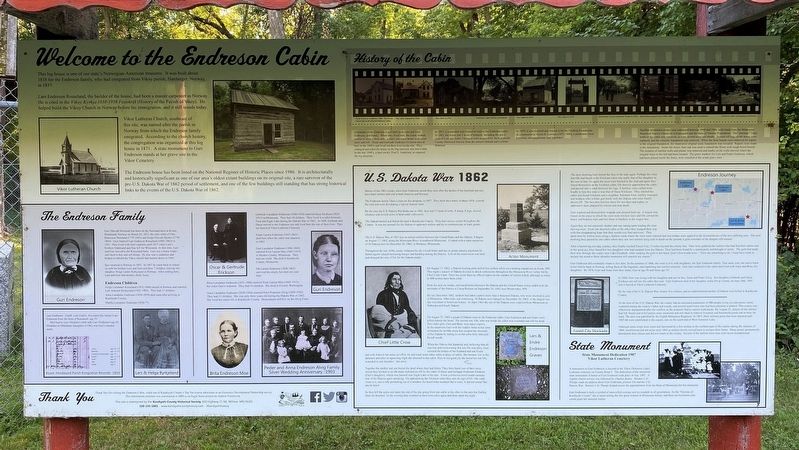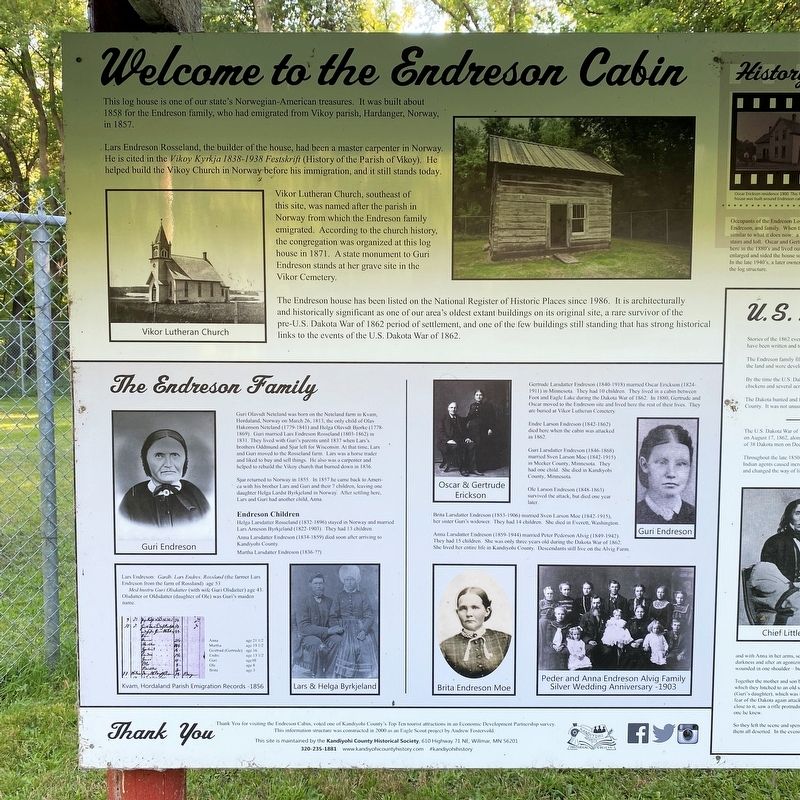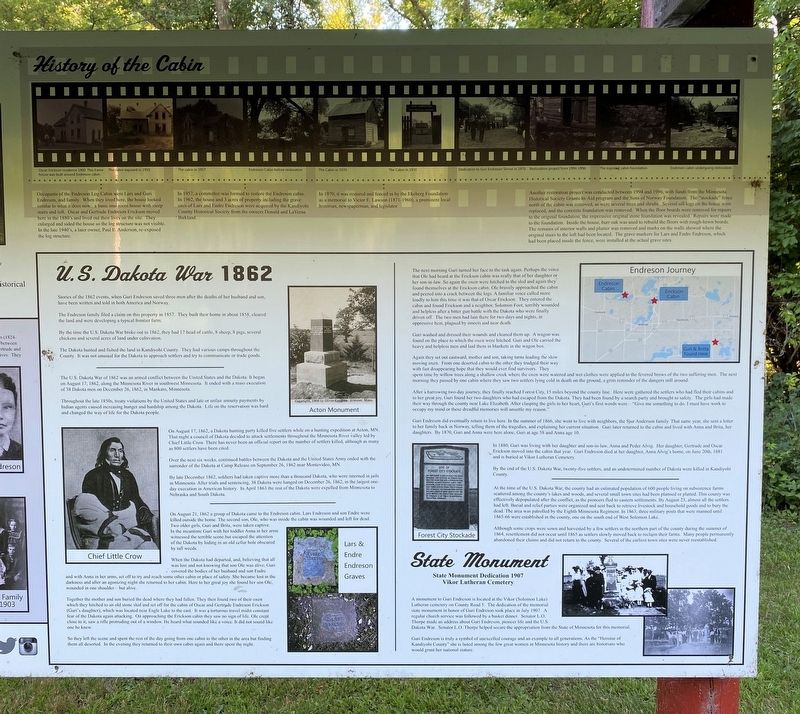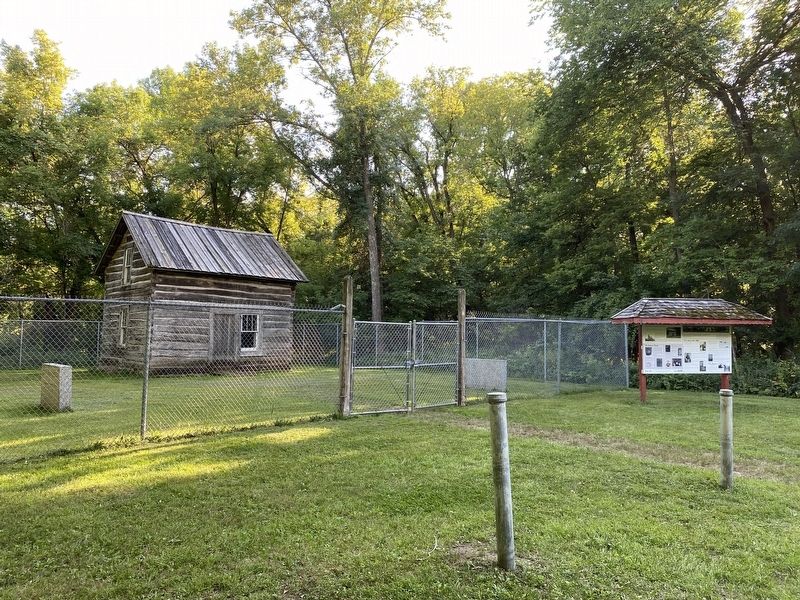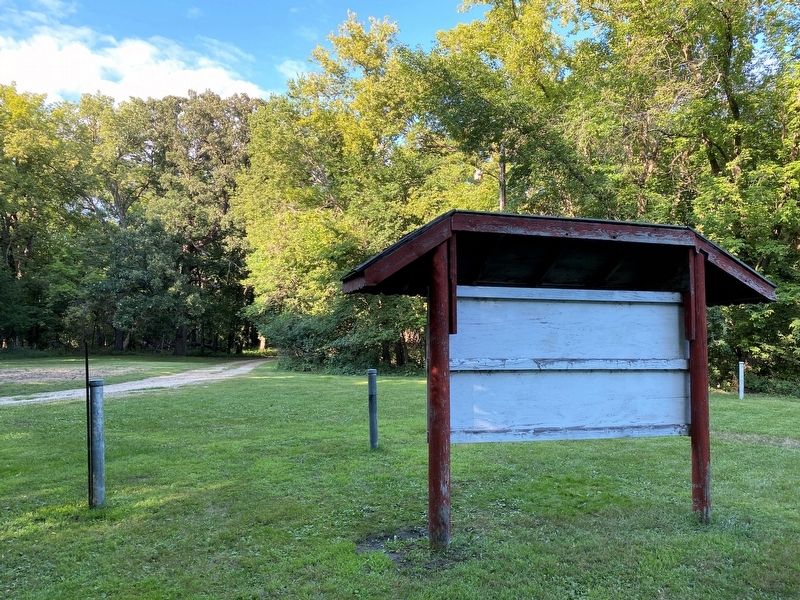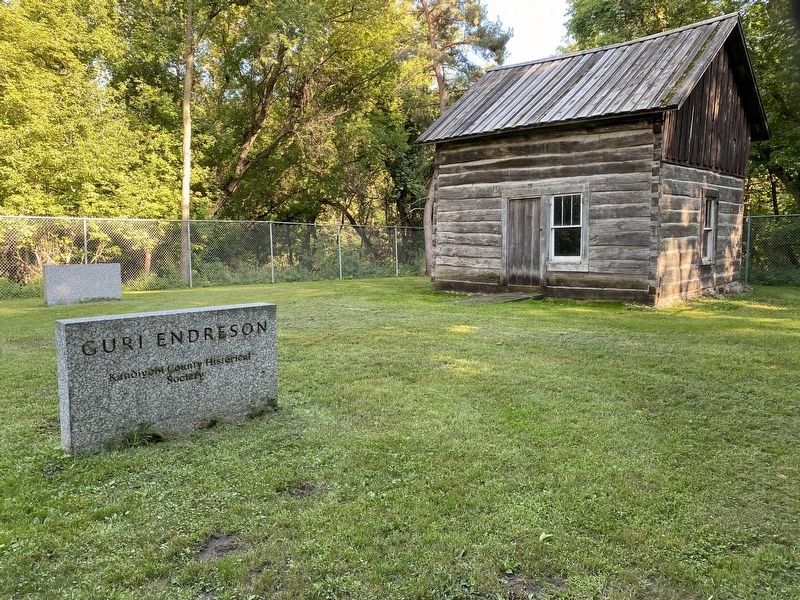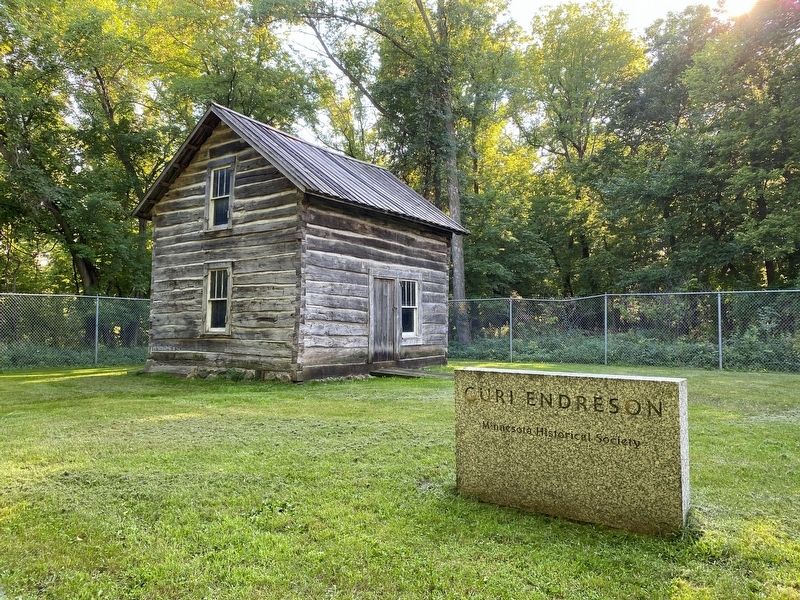Dovre Township near Willmar in Kandiyohi County, Minnesota — The American Midwest (Upper Plains)
Welcome to the Endreson Cabin
Lars Endreson Rosseland, the builder of the house, had been a master carpenter in Norway. He is cited in the Vikoy Kyrkja 1838-1938 Festskrift (History of the Parish of Vikoy). He helped build the Vikoy Church in Norway before his immigration, and it still stands today.
Vikor Lutheran Church, southeast of this site, was named after the parish in Norway from which the Endreson family emigrated. According to the church history, the congregation was organized at this log house in 1871. A state monument to Guri Endreson stands at her grave site in the Vikor Cemetery.
The Endreson house has been listed on the National Register of Historic Places since 1986. It is architecturally and historically significant as one of our area's oldest extant buildings on its original site, a rare survivor of the pre-U.S. Dakota War of 1862 period of settlement, and one of the few buildings still standing that has strong historical links to the events of the U.S. Dakota War of 1862.
Vikor Lutheran Church
The Endreson Family
Guri Olavsdt Neteland was born on the Neteland farm in Kvam, Hordaland, Norway on March 26, 1813, the only child of Olav Hakonson Neteland (1779-1841) and Helga Olavsdt Bjorke (1778-1869). Guri married Lars Endreson Rosseland (1803-1862) in 1831. They lived with Guri's parents until 1837 when Lars's brothers Oddmund and Sjur left for Wisconsin. At that time, Lars and Guri moved to the Rosseland farm. Lars was a horse trader and liked to buy and sell things. He also was a carpenter and helped to rebuild the Vikoy church that burned down in 1836.
Sjur returned to Norway in 1855. In 1857 he came back to America with his brother Lars and Guri and their 7 children, leaving one daughter Helga Lardst Byrkjeland in Norway. After settling here, Lars and Guri had another child, Anna.
Endreson Children
Helga Larsdatter Rosseland (1832-1896) stayed in Norway and married Lars Arneson Byrkjeland (1822-1903). They had 13 children.
Anna Larsdatter Endreson (1834-1859) died soon after arriving to Kandiyohi County.
Martha Larsdatter Endreson (1836-??)
Guri Endreson
Lars Endreson: Gardb. Lars Endres. Rossland (the farmer Lars Endreson from the farm of Rossland) age 53
Med hustru Guri Olsdatter (with wife Guri Olsdatter) age 43. Olsdatter or Oldsdatter (daughter of Ole) was Guri's maiden name.
Kvam, Hordaland Parish Emigration Records -1856
Lars & Helga Byrkjeland
Gertrude Larsdatter Endreson (1840-1918) married Oscar Erickson (1824-1911) in Minnesota. They had 10 children. They lived in a cabin between Foot and Eagle Lake during the Dakota War of 1862. In 1880, Gertrude and Oscar moved to the Endreson site and lived here the rest of their lives. They are buried at Vikor Lutheran Cemetery.
Endre Larson Endreson (1842-1862) died here when the cabin was attacked in 1862.
Guri Larsdatter Endreson (1846-1868) married Sven Larson Moe (1842-1915) in Meeker County, Minnesota. They had one child. She died in Kandiyohi County, Minnesota.
Ole Larson Endreson (1848-1863) survived the attack, but died one year later.
Brita Larsdatter Endreson (1853-1906) married Sven Larson Moe (1842-1915), her sister Guri's widower. They had 14 children. She died in Everett, Washington.
Anna Larsdatter Endreson (1859-1944) married Peter Pederson Alvig (1849-1942). They had 15 children. She was only three years old during the Dakota War of 1862. She lived her entire life in Kandiyohi County. Descendants still live on the Alvig Farm.
Oscar & Gertrude Erickson
Guri Endreson
Brita Endreson Moe
Peder and Anna Endreson Alvig Family Silver Wedding Anniversary -1903
History of the Cabin
Oscar Erickson residence 1900. This frame house was built around Endreson cabin.
The cabin exposed in 1950
Occupants of the Endreson Log Cabin were Lars and Guri Endreson, and family. When they lived here, the house looked similar to what it does now: a basic one-room house with steep stairs and loft. Oscar and Gertrude Endreson Erickson moved here in the 1880's and lived out their lives on the site. They enlarged and sided the house so the log structure was not visible. In the late 1940's, a later owner, Paul E. Anderson, re-exposed the log structure.
The cabin in 1957
Endreson Cabin before restoration
In 1957, a committee was formed to restore the Endreson cabin. In 1962, the house and 3 acres of property including the grave sites of Lars and Endre Endreson were acquired by the Kandiyohi County Historical Society from the owners Donald and LaVerna Birkland.
The Cabin in 1970
The Cabin in 1970
In 1970, it was restored and fenced in by the Ekeberg Foundation as a memorial to Victor E. Lawson (1871-1960), a prominent local historian, newspaperman, and legislator.
Dedication to Guri Endreson Shrine in 1970.
Restoration project from 1994-1996.
The exposed cabin foundation.
Endreson cabin undergoing restoration.
Another restoration project was conducted between 1994 and 1996, with funds from the Minnesota Historical Society Grants-In-Aid program and the Sons of Norway Foundation. The "stockade" fence north of the cabin was removed, as were several trees and shrubs. Several sill logs on the house were replaced, and the concrete foundation was removed. When the floor boards were removed for repairs to the original foundation, the impressive original stone foundation was revealed. Repairs were made to the foundation. Inside the house, burr oak was used to rebuild the floors with rough-hewn boards. The remains of interior walls and plaster was removed and marks on the walls showed where the original stairs to the loft had been located. The grave markers for Lars and Endre Endreson, which had been placed inside the fence, were installed at the actual grave sites.
U.S. Dakota War 1862
Stories of the 1862 events, when Guri Endreson saved three men after the deaths of her husband and son, have been written and told in both America and Norway.
The Endreson family filed a claim on this property in 1857. They built their home in about 1858, cleared the land and were developing a typical frontier farm.
By the time the U.S. Dakota War broke out in 1862, they had 17 head of cattle, 8 sheep, 8 pigs, several chickens and several acres of land under cultivation.
The Dakota hunted and fished the land in Kandiyohi County. They had various camps throughout the County. It was not unusual for the Dakota to approach settlers and try to communicate or trade goods.
The U.S. Dakota War of 1862 was an armed conflict between the United States and the Dakota. It began on August 17, 1862, along the Minnesota River in southwest Minnesota. It ended with a mass execution of 38 Dakota men on December 26, 1862, in Mankato, Minnesota.
Throughout the late 1850s, treaty violations by the United States and late or unfair annuity payments by Indian agents caused increasing hunger and hardship among the Dakota. Life on the reservation was hard and changed the way of life for the Dakota people.
On August 17, 1862, a Dakota hunting party killed five settlers while on a hunting expedition at Acton, MN. That night a council of Dakota decided to attack settlements throughout the Minnesota River valley led by Chief Little Crow. There has never been an official report on the number of settlers killed, although as many as 800 settlers have been cited.
Over the next six weeks, continued battles between the Dakota and the United States Army ended with the surrender of the Dakota at Camp Release on September 26, 1862 near Montevideo, MN.
By late December 1862, soldiers had taken captive more than a thousand Dakota, who were interned in jails in Minnesota. After trials and sentencing, 38 Dakota were hanged on December 26, 1862, in the largest one-day execution in American history. In April 1863 the rest of the Dakota were expelled from Minnesota to Nebraska and South Dakota.
On August 21, 1862 a group of Dakota came to the Endreson cabin. Lars Endreson and son Endre were killed outside the home. The second son, Ole, who was inside the cabin was wounded and left for dead. Two older girls, Guri and Brita, were taken captive. In the meantime Guri with her toddler Anna in her arms witnessed the terrible scene but escaped the attention of the Dakota by hiding in an old cellar hole obscured by tall weeds.
When the Dakota had departed, and, believing that all was lost and not knowing that son Ole was alive, Guri covered the bodies of her husband and son Endre and with Anna in her arms, set off to try and reach some other cabin or place of safety. She became lost in the darkness and after an agonizing night she returned to her cabin. Here to her great joy she found her son Ole, wounded in one shoulder — but alive.
Together the mother and son buried the dead where they had fallen. They then found two of their oxen which they hitched to an old stone sled and set off for the cabin of Oscar and Gertrude Endreson Erickson (Guri's daughter), which was located near Eagle Lake to the east. It was a torturous travel midst constant fear of the Dakota again attacking. On approaching the Erickson cabin they saw no sign of life. Ole crept close to it, saw a rifle protruding out of a window. He heard what sounded like a voice. It did not sound like one he knew.
So they left the scene and spent the rest of the day going from one cabin to the other in the area but finding them all deserted. In the evening they returned to their own cabin again and there spent the night.
Acton Monument
Chief Little Crow
Lars & Endre Endreson Graves
The next morning Guri turned her face to the task again. Perhaps the voice that Ole had heard at the Erickson cabin was really that of her daughter or her son-in-law. So again the oxen were hitched to the sled and again they found themselves at the Erickson cabin. Ole bravely approached the cabin and peered into a crack between the logs. A familiar voice called more loudly to him this time-it was that of Oscar Erickson. They entered the cabin and found Erickson and a neighbor, Solomon Foot, terribly wounded and helpless after a bitter gun battle with the Dakota who were finally driven off. The two men had lain there for two days and nights, in oppressive heat, plagued by insects and near death.
Guri washed and dressed their wounds and cleaned them up. A wagon was found on the place to which the oxen were hitched. Guri and Ole carried the heavy and helpless men and laid them in blankets in the wagon box.
Again they set out eastward, mother and son, taking turns leading the slow moving oxen. From one deserted cabin to the other they trudged their way with fast disappearing hope that they would ever find survivors. They spent time by willow trees along a shallow creek where the oxen were watered and wet clothes were applied to the fevered brows of the two suffering men. The next morning they passed by one cabin where they saw two settlers lying cold in death on the ground, a grim reminder of the dangers still around.
After a harrowing two-day journey, they finally reached Forest City, 15 miles beyond the county line. Here were gathered the settlers who had fled their cabins and to her great joy, Guri found her two daughters who had escaped from the Dakota. They had been found by a search party and brought to safety. The girls had made their way through the county near Lake Elizabeth. After clasping the girls to her heart, Guri's first words were — "Give me something to do. I must have work to occupy my mind or these dreadful memories will unsettle my reason."
Guri Endreson did eventually return to live here. In the summer of 1866, she went to live with neighbors, the Sjur Anderson family. That same year, she sent a letter to her family back in Norway, telling them of the tragedies, and explaining her current situation. Guri later returned to the cabin and lived with Anna and Brita, her daughters. By 1870, Guri and Anna were here alone, Guri at age 58 and Anna age 10.
In 1880, Guri was living with her daughter and son-in-law, Anna and Peder Alvig. Her daughter, Gertrude and Oscar Erickson moved into the cabin that year. Guri Endreson died at her daughter, Anna Alvig's home, on June 20th, 1881 and is buried at Vikor Lutheran Cemetery.
By the end of the U.S. Dakota War, twenty-five settlers, and an undetermined number of Dakota were killed in Kandiyohi County.
At the time of the U.S. Dakota War, the county had an estimated population of 600 people living on subsistence farms scattered among the county's lakes and woods, and several small town sites had been planned or platted. This county was effectively depopulated after the conflict, as the pioneers fled to eastern settlements. By August 23, almost all the settlers had left. Burial and relief parties were organized and sent back to retrieve livestock and household goods and to bury the dead. The area was patrolled by the Eighth Minnesota Regiment. In 1863, three military posts that were manned until 1865-66 were established in the county, one on the south end of West Solomon Lake.
Although some crops were sown and harvested by a few settlers in the northern part of the county during the summer of 1864, resettlement did not occur until 1865 as settlers slowly moved back to reclaim their farms. Many people permanently abandoned their claims and did not return to the county. Several of the earliest town sites were never reestablished.
State Monument
State Monument Dedication 1907
Vikor Lutheran Cemetery
A monument to Guri Endreson is located at the Vikor (Solomon Lake) Lutheran cemetery on County Road 5. The dedication of the memorial state monument in honor of Guri Endreson took place in July 1907. A regular church service was followed by a basket dinner. Senator L.O. Thorpe made an address about Guri Endreson, pioneer life and the U.S. Dakota War. Senator L.O. Thorpe helped secure the appropriation from the State of Minnesota for this memorial.
Guri Endreson is truly a symbol of unexcelled courage and an example to all generations. As the "Heroine of Kandiyohi County" she is listed among the few great women in Minnesota history and there are historians who would grant her national stature.
Endreson Journey
Forest City Stockade
Erected 2000 by Andrew Fostervold and the Kandiyohi County Historical Society.
Topics. This historical marker is listed in these topic lists: Churches & Religion • Settlements & Settlers • Wars, US Indian. A significant historical year for this entry is 1858.
Location. 45° 11.041′ N, 95° 6.375′ W. Marker is near Willmar, Minnesota, in Kandiyohi County. It is in Dovre Township. Marker can be reached from 67th Avenue Northwest, 0.6 miles west of County Road 5 Northwest (County Highway 5), on the left when traveling west. Touch for map. Marker is at or near this postal address: 3669 67th Ave NW, Willmar MN 56201, United States of America. Touch for directions.
Other nearby markers. At least 8 other markers are within 5 miles of this marker, measured as the crow flies. Guri Endresen-Rosseland (approx. 1.4 miles away); Turning Back Time (approx. 1.4 miles away); Haugen Homestead (approx. 2.3 miles away); Kandiyohi County's First Church (approx. 4.1 miles away); The Erickson Cabin (approx. 4.1 miles away); Berger Thorson Killed (approx. 4˝ miles away); Foot Cabin (approx. 4˝ miles away); Fullerville (approx. 4.6 miles away). Touch for a list and map of all markers in Willmar.
Related markers. Click here for a list of markers that are related to this marker.
Credits. This page was last revised on August 30, 2023. It was originally submitted on August 30, 2023. This page has been viewed 131 times since then and 66 times this year. Photos: 1, 2, 3, 4, 5, 6, 7. submitted on August 30, 2023.
